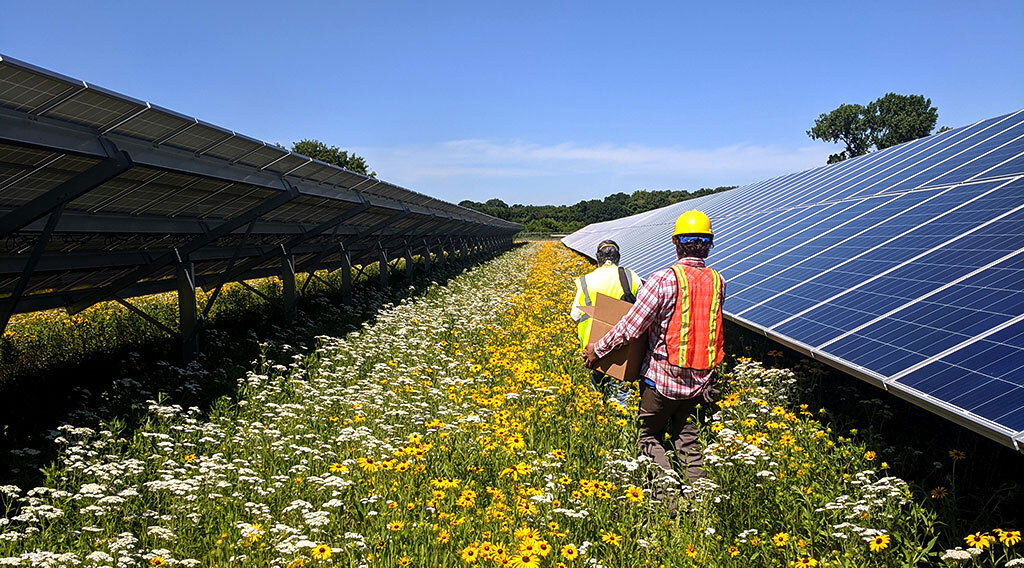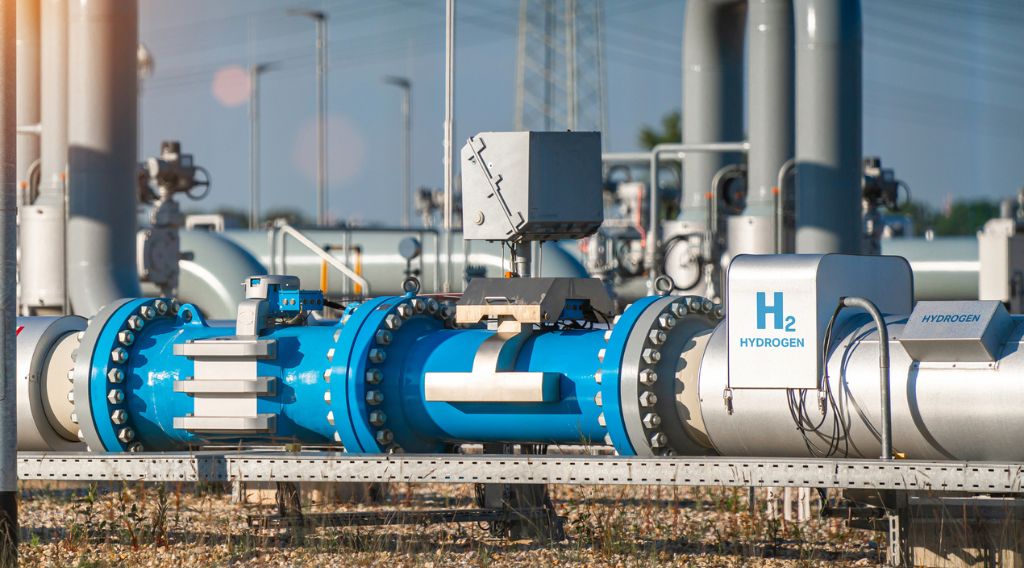 Solar energy is not only important to reaching a zero-carbon energy system—solar projects can, with appropriate siting and design, also deliver many benefits to local communities where projects are sited. Deploying the level of solar needed to decarbonize our economy will require addressing siting and regulatory processes which are increasingly a barrier to solar project development. The Great Plains Institute is fostering a new paradigm in the deployment of community- and utility-scale solar development; what we call the co-benefits approach to solar. We’re working with state, regional, and national partners to identify how energy development can both help solve the climate crisis and deliver local benefits to the host community.
Solar energy is not only important to reaching a zero-carbon energy system—solar projects can, with appropriate siting and design, also deliver many benefits to local communities where projects are sited. Deploying the level of solar needed to decarbonize our economy will require addressing siting and regulatory processes which are increasingly a barrier to solar project development. The Great Plains Institute is fostering a new paradigm in the deployment of community- and utility-scale solar development; what we call the co-benefits approach to solar. We’re working with state, regional, and national partners to identify how energy development can both help solve the climate crisis and deliver local benefits to the host community.
Here are three takeaways:
- Community- and utility-scale solar development can deliver benefits beyond zero-carbon energy.
- Groundwater protection, increased tax base, increased landowner return, habitat restoration or enhancement; these are among the co-benefits of appropriately sited and designed solar development.
- The co-benefits approach to solar reflects two years of GPI-led discussions with agricultural, natural resource, water quality, and rural stakeholders about making solar development benefit both the climate and the community.
Solar projects depend on local decision making with far-reaching impacts
According to the National Renewable Energy Laboratory (NREL), utility-scale solar installations could cover almost 2 million acres of land in the United States by 2030. Yet cost-effective deployment of these potential solar installations depends on successful approvals from local and state decision makers and regulators whose primary concern is not clean energy production. Deploying clean energy and mitigating the climate crisis are generally not part of the decision making process by officials whose responsibility is evaluating siting applications, approving land use permits, and considering state and/or local environmental impacts of development.
Clean energy development is designed to provide energy to the electric grid while avoiding carbon emissions (providing climate benefits). If we look at it from this perspective, clean energy development is identical to other kinds of power generation; people who live near the development get the same level of climate benefit from the energy as people who live in other communities or states. Similar to other forms of energy generation, the people who live near the development bear the local impacts—both positive and negative—of the land use and energy production. These impacts can range from creating jobs and growing the tax base to air and water quality impacts, noise, traffic, fuel deliveries, visual impacts, and potential incompatibility with other land uses.
A co-benefits approach to solar can change the paradigm for solar project siting and design
The co-benefits approach to solar focuses on how people who live in the same community as the solar development either benefit from or are burdened by the solar development, regardless of the clean energy benefit. The approach emphasizes deliberate design and operation to minimize local burdens and maximize local benefits, creating a no-regrets proposal.
For instance, if a city protects its drinking water supplies by restoring wellhead recharge areas to perennial grass or prairie ground cover that reduces nitrate contamination and health risk, does it really matter if the site is also a solar farm?
And what if protecting its drinking water aquifer increased the economic return to the private landowners of the recharge areas, so that the landowner got a better financial return on the land for protecting the aquifer than not protecting it? And what if protecting the aquifer created new habitat for pollinators and game birds? What if protecting the aquifer increased local property tax revenues from the parcel over the previous agricultural use?
Groundwater protection, increased tax base, increased landowner return, and habitat restoration or enhancement; these are co-benefits of solar development if the solar development is sited and designed to capture these benefits.
This co-benefits approach focuses first on the economy and environment of local communities while enabling the community- and utility-scale solar development needed to reach a zero-carbon energy system.
What are co-benefits?
The concept of co-benefits is long established in climate change work and environmental regulation:
- The Intergovernmental Panel on Climate Change Fourth Assessment report in 2007 defined climate action co-benefits as “benefits of policies that are implemented for various reasons at the same time, including climate change mitigation, acknowledging that most policies designed to address GHG mitigation also have other, often at least equally important, rationales (e.g. related to objectives of development, sustainability, and equity).”
- In 2003, the US Office of Management and Budget (OMB) defined a related concept, ancillary benefits, as “a favorable impact of [a] rule that is typically unrelated or secondary to the statutory purpose of the rulemaking.”
- The International Climate Initiative in Germany notes “co-benefits of climate change mitigation include local economic value creation, new employment opportunities, cleaner air, access to affordable energy, and rural development.”
- The US EPA created the COBRA tool (Co-Benefits Risk Assessment) specifically to help “local governments reduce air emissions with cost-effective energy strategies, and achieve multiple co-benefits” that include the health and economic benefits of policies that reduce air pollution.
Moreover, co-benefits are frequently realized at the local level, where the climate or energy-related development occurs, and where regulatory and land use decisions are critical for projects to proceed.
NREL studies solar development design that keeps the community in mind; deliberate low-impact high-value solar development design that can “improve soil health, retain water, nurture native species, produce food, and provide even lower-cost energy to local communities.” Capturing local benefits is critical to widespread solar deployment. NREL Senior Energy Planner Megan Day notes, “We will only achieve widespread PV [photovoltaic] deployment rates if communities are comfortable dedicating some of their land to solar development. Demonstrating the effectiveness of low-impact, pollinator-friendly practices helps communities realize they can guide development in ways that capture multiple benefits beyond energy production.”
Engaging communities on the co-benefits of solar
For the past two years, GPI facilitated discussions with agricultural, natural resource, water quality, and rural character stakeholders about whether and how solar development can be changed to create co-benefits. These discussions identified several co-benefit priorities, some of which have been successfully implemented, and others that need additional study and demonstration to be deployed at scale. This post is the first in a series that will explore the ongoing work of creating co-benefits through solar energy development:
- Solar-integrated agriculture, using solar development to enhance the agricultural business models and forms of production typically seen in the Midwest.
- Solar and water quality protection, where solar development is designed as green infrastructure that improves water quality in streams, lakes, and rivers.
- Solar and drinking water protection, where solar development can accelerate the efforts by rural communities to reduce nitrate contamination in drinking water supplies.
- Solar and rural character, identifying the opportunities to limit impacts and improve growth management goals that preserve rural and agricultural character.
While clean energy delivers benefits across the world in the form of climate mitigation, it can also deliver a variety of benefits to local communities. If deliberately designed to do so, solar energy development can deliver broad benefits to communities. A co-benefits approach to solar development is essential to enabling the scale of projects needed to reach our climate and clean energy goals.
Contact the Renewable Energy team at [email protected] for more information on the benefits of community-scale and utility-scale solar in your area.
You can stay up-to-date on all of GPI’s work by signing up for our monthly newsletter.
***
Photo credit: University of Minnesota Professor David Mulla’s photo of university researchers preparing to install instrumentation to monitor the solar garden for water quality impacts and benefits as part of the PV-SMaRT project.

